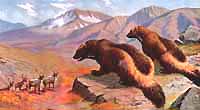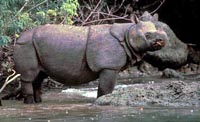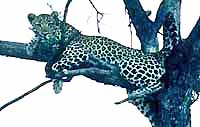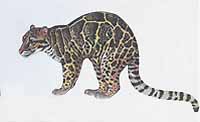|
# |
Species
[range] |
Photo/art [see credits]
all photos taken in wild unless stated |
Reason for choice |
DR seen? |
|
11 |
Blue Whale
Balaenoptera musculus
[oceans] |
|
The largest mammal ever to have lived, this pelagic giant was rapidly going extinct a few decades ago before a whaling ban finally was instituted. It is now coming back in replenished numbers and is often regular in late summer in Monterey Bay. It is always an extremely impressive sight.
|
Yes |
12 |
Javan Rhinoceros
Rhinoceros sondaicus
[Java & Vietnam?]
|
|
It is
almost impossible to see the lowland one-horned rhino in the
forests of s.e. Asia, as it is one of the rarest mammals on earth. A recent estimate is fewer than 60 rhinos in two tiny populations — one in Java and the other (still?) in Vietnam. The few remaining are in protected areas but still face threats of poaching for their horns. |
No |
|
13 |
any wild Elephant
Loxodonta or Elephas
[Africa & India] |
|
There are 3 species of elephants:
the huge Savanna Elephant Loxodonta africana of e. & s.
Africa (left), the smaller Forest Elephant L. cyclotis of c.
& w. Africa, and the Indian Elephant Elephas maximus.
Each is incredibly impressive to observe in the wild, but numbers continues decline.
|
Yes; 3 of 3 |
|
14 |
Cheetah
Acinonyx jubatus
[e. Africa] |
|
The fastest mammal in the world
as it chases down antelope in short sprints, the Cheetah is still quite
seeable in some e. African parks. But its range (once including w.
Asia) has been disappearing and fragmenting for years. Brothers often
hunt together. A superb, sleek, and beautiful cat. |
Yes |
|
15 |
Leopard
Panthera pardus
[Africa & tropical Asia] |
|
Leopards can be reasonable common
in parts of Africa or s. Asia, but seeing one is another thing. They
are elusive and often nocturnal. Despite months in their habitat, I have seen
only a handful. Beautiful and powerful, they have always been among my
favorite animals. Loners except during mating, they personify wild cats. |
Yes |
|
16 |
Indian Rhinoceros
Rhinoceros unicornis
[tropical s. Asia] |
|
The huge one-horned Indian Rhino has incredible medieval-appearing 'body armor.' Although Endangered, it is seeable at
Kaziranga NP, India or Chitwan NP, Nepal, but almost no where else. |
Yes |
| 17 |
Aye-aye
Daubentonia madagascariensis
[Madagascar] |
|
The Aye-Aye is the stuff of
legends on Madagascar, persecuted as 'bad luck' to anyone who sees it.
Actually it is a fascinating nocturnal lemur with a tremendously
elongated middle finger for extracting grubs hidden deep in crevices.
It is everywhere rare, local, and little known. |
No |
| 18 |
Wolverine
Gulo gulo
[Holarctic] |
 |
The world's largest mustelid (family of weasels, otters, badgers), the Wolverine is an absolutely fearless carnivore. It has a huge home range and seems impossible to see without an aircraft or radio-tracking. A very few in the alpine Sierra Nevada are California's rarest mammal. |
No |
| 19 |
any Orca
[Killer Whale]
Orca orcinus +
[oceans] |
 |
From pole to the Equator, this marine predator may have the widest range of any non-human mammal on earth. It is everywhere incredibly impressive – huge, fast, beautiful & deadly. Some migratory pods feed on large baleen whales, but others feast on salmon or seals; all have impressive social systems. It is possible that more than one species is involved. |
Yes |
|
20 |
any Clouded Leopard
Neofelis nebulosa & N. diardi
[s.e. Asia] |
|
Clouded Leopards might be
considered a bridge between the great cats and the small cats. They have a
gorgeous coat but are hardly ever seen in deep forests of s.e. Asia.
Both species, N. nebulosa of the mainland & N. diardi of Borneo/Sumatra, are primarily arboreal and nocturnal. Only on Borneo is it seen with luck on night-drives. |
No |
|
|
Links to all of the "top 50":
RESOURCES & CREDITS
|
|
FURTHER READING
* For Blue Whale: I haven't read anything wonderful yet about Blue Whales, although I do like the art in Richard Ellis's (1980) The Book of Whales.
* For Savannah Elephant: Mark &
Delia Owens' (1989) The Eye of the Elephant is a riveting
account of their attempts to stop elephant poaching in North Luanga
Park, Zambia, and has much about elephant behavior and biology.
* For Aye-aye: Gerald Durrell's
(1993) The Aye-Aye and I: A Rescue Mission in Madagascar is
engaging and entertaining, and there are many life history facts here
and there.
* For Leopard: Some old stories are
in Jim Corbett's (1946) Man-Eaters of Kumaon (about India;
see Tigers, above) but I haven't get read a Leopard book that got my
full attention. Some nice Leopard stories are in Mark & Delia
Owens' (1984) Cry of the Kalahari: Seven Years in Africa's Last
Great Wilderness, though.
* For Wolverine: Douglas Chadwick's (2010) The Wolverine Way is one of the best written mammal books ever. Focusing on his experiences doing Wolverine research at Glacier NP, Montana, his long hours in the field gave him time to consider larger concepts about life in general. Less philosophical than The Snow Leopard, but personal and insightful. The reader also learns about everything there is to know about Wolverines, and one become astonished at their power and determination. A great book.
* For Orca: I've been tangentially involved (i.e., contributed photos) to the growing Orca photo catalog project by Nancy Black, the late Richard Ternullo and others, so I've mostly been interested in research papers. Some well-researched popular accounts of natural history are Gerard Gormley's (1990) Orcas of the Gulf [without photos; about Gulf of Maine population] and Peter Knudtson's (1996) Orca: Vision of the Killer Whale [with many photos; about Puget Sound population].
CREDITS:
All artworks are copyrighted by the artist (as detailed below) and are
either used with permission or are posted here in reliance on the
non-commercial "fair use" doctrine; all rights are reserved by the
artist
* Bruce Pearson painted Aye-aye (from Burton & Pearson's 1987 Collins
Guide to Rare Mammals of the World)
* Walter Weber painted Wolverine (from National Geographic's 1960 Wild Animals of North America
* Karen Phillipps painted Clouded Leopard (from
Payne & Francis's 1985 Field Guide to Mammals of Borneo)
All the photographs are copyrighted by the photographer
(as detailed below) and are used with permission; all rights are
reserved to the photographer
* Alain Compost photographed the Java Rhinoceros [published IUZN website, fair use doctrine]
* Don Roberson photographed Cheetah (South Africa),
Indian Rhinoceros (India), Savannah Elephant (Tanzania), Leopard
(Kenya), and Blue Whale & Orca (Monterey Bay, California)
|
TOP
Page created 1-6 June 2002, updated 20 Aug 2002, revised 30 Aug 2010, 7 Dec 2014 & 18 Feb 2021 |
|









